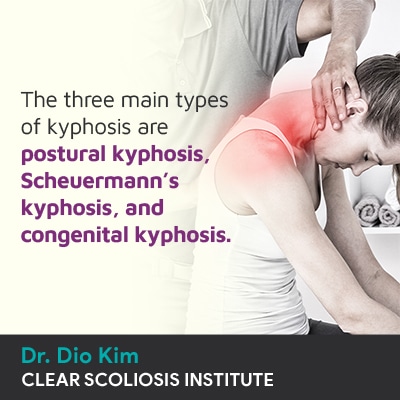
When it comes to maintaining optimal spinal health, the spine’s natural and healthy curves need to be in place. Kyphosis refers to the spine’s outward curve at the thoracic section, and if this curve becomes excessive, it can cause a roundback appearance.
Kyphosis involves the development of an excessive spinal curvature of the thoracic spine; treatment needs are case-specific and based on condition type, but can involve a combination of chiropractic care and kyphosis-specific exercises that can achieve postural remodeling and increase core strength.
The main goal of treating any spinal condition that involves the development of an unnatural spinal curve is to reduce the unhealthy curve as much as possible, thus restoring the spine’s healthy curves.
The spine doesn’t just have one healthy curve; each of the spine’s main sections has its own type of spinal curvature, and those curves make the spine flexible, strong, and better able to handle mechanical stress.
The spine’s three main sections include the neck (cervical spine), middle/upper back (thoracic spine), and the lower back (lumbar spine).
The thoracic spine features a kyphotic curve, and while there is a natural range of curvature size, if a person’s degree of thoracic kyphosis falls beyond a normal range, the curve has become excessive and potentially problematic.
A healthy range of thoracic kyphosis would fall between 20 and 45 degrees, with hyperkyphosis (excessive kyphosis) generally diagnosed at 45+ and/or 50+ degrees.
When it comes to treating a patient with hyperkyphosis, the goal is to reduce the curve and increase core strength; let’s explore how that can be achieved, but before we get there, condition type has to be addressed.
As is the case with most spinal conditions, in order to be treated effectively, its underlying cause, when known, has to be determined and addressed, and this will differ between various condition types.

Postural kyphosis: a non-structural spinal condition caused by chronic poor posture. As a non-structural condition, this is the simplest type to treat.
Scheuermann’s kyphosis: a structural condition that’s more complex to treat and features a rigid curve.
Congenital kyphosis: a structural spinal condition that’s caused by a malformed spine. Congenital kyphosis develops as the spine is forming in utero, so babies are born with the condition.
Once causation is determined, I know what type of kyphosis I’m dealing with, and can design treatment plans accordingly.
Kyphosis treatment needs/options will be case-specific, based on condition type, severity, and experienced symptoms.
When a patient’s kyphosis is non-structural, as is the case with postural kyphosis, a change in position can alter the kyphotic curve; this isn’t true of structural conditions, which is why they are more complex to treat.
When a condition is postural, generally, physical therapy is enough to improve a patient's posture and increase core strength so the spine is optimally supported.
When it comes to kyphosis that’s structural, treatment needs are more complex because no change in position can alter the excessive-kyphotic curve, and kyphosis tends to get worse over time, especially if left untreated.
For structural kyphosis, a combination of condition-specific chiropractic care and rehabilitation is a typical course of treatment.
For young patients whose spines are still growing, corrective bracing can be another helpful facet of treatment by pushing the spine into a healthier position, and for adults, corrective bracing can help with pain management, slowing/stopping progression, and in some cases, a curvature reduction.
Chiropractic care can involve a series of chiropractic techniques and manual adjustments that are used to modify the position of excessively-tilted vertebrae so the spine can be realigned and restoring a healthy level of kyphosis can be worked towards.
Spine- and condition-specific exercises can help with postural remodeling, increasing core strength, and certain exercises are known to stimulate areas of the brain for enhanced brain-body communication.
Now that we’ve touched on some general treatment disciplines, let’s talk about some specific exercises that can help augment corrective treatment results by improving posture and increasing core strength.

Also, when it comes to treating kyphosis that’s structural, no exercise alone will be enough to reduce a kyphotic curve on a structural level; exercises/stretches will need to be integrated into a treatment plan that includes condition-specific chiropractic care, manual adjustments, and when appropriate, corrective bracing.
When it comes to using exercise as a facet of kyphosis-treatment, studies support their value, and consistency is important; it’s recommended that the following exercises should be performed regularly and at least three to four times a week.
The mirror image exercise is about positioning one's body opposite to the problematic posture:
When done correctly and consistently, this can help address a slouching posture that can contribute to the development of an excessively-rounded upper back.
Superman extensions target core strength, and this can help with a variety of spinal conditions because it’s not just the spine that works hard to maintain its healthy curves, but also its surrounding muscles.
A strong core means the spine can be optimally supported and stabilized.
As an unnatural spinal curve develops, the body is affected by uneven forces, and the goal of life extensions is to address the muscle imbalance that can develop as a result.
Holding the life extension position improves posture, extends and stretches tight chest muscles, and strengthens the spinal-extensor muscles that support the spine on both sides.
Performing a shoulder blade squeeze can help reduce tension and strengthen upper-back muscles.
This exercise can be particularly helpful for postural kyphosis as it facilitates healthy posture and a neutral/natural back position.
This exercise can be repeated as often as desired to achieve postural remodeling by reminding patients what healthy posture feels like; it places the spine in a relaxed and neutral position, taking it out of its excessively-curved position.
When performed correctly and consistently, the aforementioned kyphosis exercises can help to reduce a kyphotic curve that’s postural, but other forms of treatment, like condition-specific chiropractic care and corrective bracing, are also needed to effectively address structural conditions.
The main goal of kyphosis exercises is to strengthen the spine’s surrounding muscles; this is to improve posture and ensure the spine is being optimally supported and stabilized.
When it comes to kyphosis, we’re talking about an excessive outward curvature of the thoracic spine, and when an unnatural spinal curve develops, it exposes the spine, its surroundings, and the body in general, to uneven forces.
The three main types of kyphosis are postural kyphosis, Scheuermann’s kyphosis, and congenital scoliosis.
When it comes to treatment options for kyphosis, needs are case-specific based on important condition/patient variables such as age, severity, type, and experienced symptoms.
Postural kyphosis is a non-structural condition so is the simplest to treat with condition-specific rehabilitation therapy and a series of kyphosis exercises to help improve posture and core strength.
Scheuermann’s kyphosis and congenital kyphosis are structural conditions so are more complex to treat; when a spinal condition is structural, it’s caused by a structural abnormality within the spine itself, so treatment has to, first and foremost, impact it on a structural level.
Condition-specific chiropractic care can work towards adjusting the position of the most-tilted vertebrae to reduce a kyphotic curve, restoring more of the spine’s healthy curves and biomechanics.
As a CLEAR-certified scoliosis chiropractor, I specialize in treating spinal conditions that involve a loss of its healthy curves, and while there are never treatment guarantees, by applying a proactive conservative chiropractic-centered treatment approach, kyphotic curves can be reduced and core muscle strength can be improved.

CLEAR provides a unique and innovative way of understanding scoliosis. Sign up to receive facts and information you won’t find anywhere else.
